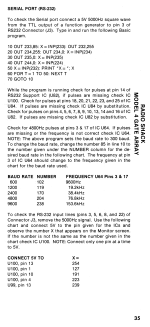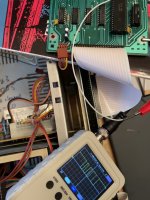When it comes down to IC's there were so many variations through the ages I would not be able to answer the TR1602 vs TR1865 differences, but a quick look at both specification sheets (attached below) seems to indicate they are compatible to each other.
I have only repaired two of these RS232C boards in the past and both problematic chips were the U6/U10 Quad D Flipflop Chips 74LS174 you could test those first
Eudimorphodon has a point, and suggest checking on the U3/U4 Buffer chips as well.
Sams Service Manual on the RS232C suggests the following procedure to find the issue:
SERIAL PORT (RS-232 BOARD)
Check for - 12.8V at pin 4, 12.0V at pin 3 and 5.0V at pin 1 of Connector P3 on the Serial Interface board.
If any of the voltages are not correct, refer to the "POWER SUPPLY" section of this Troubleshooting Guide.
Check Connector P2 on the Serial Interface board and Connector J8 on the System board for good connections and check the ribbon cable for possible breaks.
To check the Serial Interface board, connect a 5-volt, 5000Hz square wave from the TTL output of a Function Generator to pin 10 of Line Receiver IC (U11). Type in and
run the following Basic program.
10 OUT 233,85: X = INP(233): OUT 232,255
20 OUT 234,255: OUT 234,0: X = INP(234)
30 OUT 235,0: X = INP(235)
40 OUT 224,0: X=INP(224)
50X = INP(232): PRINT "X=";X
60FORT = 1 TO 50: NEXT T
70 GOTO 10
While the program is running, check for pulses at pins 1, 4 thru 7, 9 thru 12 and 15 of the Address Decoder IC (U8). If pulses are missing at pin 1 of IC U8, check Decoder IC (U40)
on the System board. If pulses are missing at pin 15 of IC U8, check Decoder IC (U41) on the System board. If pulses are missing at pins 4 thru 7 or 9 thru 12 of IC U8, check IC U8.
Check for pulses at pins 1, 2 and 4 of IC U7. If pulses are missing at pins 1, 2 or 4 of IC U7, check IC U7. If pulses are present at pins 1,2 and 4 of IC U7, check for 4800Hz pulses
at pins 3 and 17 of the Baud Rate Generator IC (U1). If pulses are missing or the frequency is not correct at pin 3 or 17 of IC U1, check IC U1. Note: The above program sets the
baud rate to 300 baud. To change the baud rate, change the number 85 in line 10 of the above program to the number given under the NUMBER column for the desired baud rate
in the following chart. The frequency at pins 3 and 17 of IC U1 should change to the frequency given in the chart for the baud rate used.
Check for pulses at pins 2, 5, 7, 10, 12 and 15 of Flip/Flop IC (U6). If pulses are missing at any of the pins check IC U6. If pulses are present at pins 2, 5, 7, 10, 12 and 15 of IC U6,
check for pulses at pins 3, 6, 8 and 11 of IC U12. If pulses are missing at any of the pins check IC U12. If pulses are present at pins 3, 6, 8 and 11 of IC U12, check for pulses at
pin 3 of IC U16. If pulses are missing at pin 3 check IC U16.
Check for pulses at pins 5 thru 15, 19, 21, 22, 25 and 34 of UART IC (U2). If pulses are missing at pins 21 or 34 of IC U2 check IC U7. If pulses are missing at pins 5 thru 15, 19, 22 or
25 of IC U2, check IC U2. If pulses are present at pins 5 thru 15, 19, 21, 22, 25 and 34 of IC U2 check for pulses at pin 11 of IC U16. If pulses are missing at pin 11 check IC U16.
Check for pulses at pin 9 of Flip/Flop IC (U10) and pin 1 of Tri-State Buffer IC (U9). If pulses are missing at pin 9 of IC U10, check Decoder IC (U41) on the System board. If pulses
are missing at pin 1 of IC U9, check Decoder IC (U40) on the System board.
To check the RS-232 input lines (pins 3, 5, 6, 8 and 22 of Connector P1), remove the 5000Hz signal from pin 10 of IC U11. Use the following chart and connect 5.0V to the pin given
for Line Receiver ICs U11 or U15 and observe the number X that appears on the Monitor screen. If the number is not the same as the number given in the chart check the buffer IC
being tested (IC U11 or U15)and check Tri-State Buffer (U5). Note:
Connect only one pin at a time to 5.0V.
To check the interrupt select lines, pins 5, 7 and 10 of Flip/Flop IC (U10), stop the above program (press the BREAK key), type OUT 224,112 and press the ENTER key.
Check for a High logic reading at pins 5, 7 and 10 of IC U10. If any of the logic readings are not correct, check IC U10.
NOTE: The Computer will lock up after OUT 224,112 is entered. Press the RESET button to reset the Computer.




